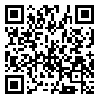BibTeX | RIS | EndNote | Medlars | ProCite | Reference Manager | RefWorks
Send citation to:
URL: http://tumj.tums.ac.ir/article-1-7036-en.html
2- Department of Hematology, Kermanshah University of Medical Sciences, Kermanshah, Iran
3- Department of Laboratory Hematology and Blood Banking, Tehran University of Medical Sciences, Tehran, Iran. ,
Background: Presently, the graphical data of blood cells (histograms and cytograms or/ scattergrams) that they are usually available in all modern automated hematology analyzers are an integral a part of automated complete blood count (CBC). To find incorrect results from automated hematology analyzer and establish the samples that require additional analysis, Laboratory employees will use those data for quality control of obtaining results, to assist identification of complex and troublesome cases.
Methods: During this descriptive analytic study, in addition to erythrocyte graphs from variety of patients, referring from March 2013 to Feb 2014 to our clinical laboratory, Zagros Hospital, Kermanshah, Iran, are given, the papers published in relevant literature as well as available published manuals of automatic blood cell counters were used. articles related to the key words of erythrocyte graphs and relevant literature as well as available published manuals of automatic blood cell counters were searched from valid databases such as Springer Link, google scholar, Pubmed and Sciencedirect. Then, the articles related to erythrogram, erythrocyte histogram and hematology analyzer graphs are involved in diagnosis of hematological disorder were searched and selected for this study.
Results: Histograms and different automated CBC parameter become abnormal in various pathologic conditions, and can present important clues for diagnosis and treatment of hematologic and non-hematologic disorders. In several instances, these histograms have characteristic appearances in an exceedingly wide range of pathological conditions. In some hematologic disorders like iron deficiency or megaloblastic anemia, a sequential histogram can clearly show the progressive treatment and management.
Conclusion: These graphical data are often accompanied by other automated CBC parameter and microscopic examination of peripheral blood smears (PBS), and can help in monitoring and interpretation of abnormal morphological changes. In the diagnosis and monitoring of anemias, analysis of histograms could also be considered as a new parameter in the combine with red blood cell indices. Histograms ought to use as a screening tool, and not considered diagnostic for pathological conditions.
| Rights and permissions | |
 |
This work is licensed under a Creative Commons Attribution-NonCommercial 4.0 International License. |





